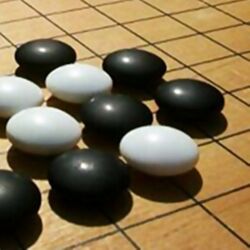Software:Go strategy
| Part of a series on |
| Go |
|---|
 |
| Game specifics |
|
| History and culture |
| Players and organizations |
| Computers and mathematics |
In the game of Go, strategy deals with global influence, interaction between distant stones, with keeping the whole board in mind during local fights and other issues that involve the overall game.[1] It is therefore possible to allow a tactical loss when it confers a strategic advantage.
Go is not easy to play well. With each new level (rank) comes a deeper appreciation for the subtlety and nuances involved and for the insight of stronger players. The acquisition of major concepts of the game comes slowly. Novices often start by randomly placing stones on the board, as if it were a game of chance; they inevitably lose to experienced players who know how to create effective formations. An understanding of how stones connect for greater power develops, and then a few basic common opening sequences may be understood. Learning the ways of life and death helps in a fundamental way to develop one's strategic understanding of weak groups. It is necessary to play some thousands of games before one can get close to one's ultimate potential Go skill. A player who both plays aggressively and can handle adversity is said to display kiai or fighting spirit in the game.
Familiarity with the board shows first the tactical importance of the edges, and then the efficiency of developing in the corners first, then sides, then center. The more advanced beginner understands that territory and influence are somewhat interchangeable—but there needs to be a balance. This intricate struggle of power and control makes the game highly dynamic.
Basic concepts
Basic strategic aspects include the following:
- Connection: Keeping one's own stones connected means that fewer groups need defense.
- Cut: Keeping opposing stones disconnected means that the opponent needs to defend more groups.
- Life: This is the ability of stones to permanently avoid capture. The simplest way is for the group to surround two eyes (separate empty areas), so that filling one eye will not kill the group and therefore be suicidal.
- Death: The absence of life coupled with the inability to create it, resulting in the eventual removal of a group.
- Invasion: Setting up a new living position inside an area where the opponent has greater influence, as a means of balancing territory.
- Reduction: Placing a stone far enough into the opponent's area of influence to reduce the amount of territory he/she will eventually get, but not so far in that it can be cut off from friendly stones outside.
The strategy involved can become very abstract and complex. High-level players spend years improving their understanding of strategy.
Opening strategy
In the opening of the game,[2] players will usually play in the corners of the board first, as the presence of two edges make it easier for a player to surround territory and establish his stones.[3] After the corners, focus moves to the sides, where there is still one edge to support a player's stones.[3] Opening moves are generally on the third and fourth line from the edge, with occasional moves on the second and fifth lines. In general, stones on the third line offer stability and are good defensive moves,[4] whereas stones on the fourth line influence more of the board and are good attacking moves.[5]
In the opening, players often play established sequences called joseki,[6] which are locally balanced exchanges. Choosing the right joseki that also gives a good result globally is one of the challenges faced by good players. It is generally advisable to keep a balance between stability and influence. Which of these gets precedence is often a matter of individual taste.
Ladders
The ladder is a traditional technique that allows the player to force the opponent to the edge of the board or a dead end and thus, capturing the opponent's chain. However, in the chart, if there were a white stone at G, white could break out of the ladder and play A. Black then would be in Double Atari.[notes 1][7]
Notes
- ↑ Double Atari is when a stone threatens 2 of the opponent's chains, resulting in a capture of at least one of the chains.
References
- ↑ Sensei's Library. "Strategy". http://senseis.xmp.net/?Strategy.
- ↑ Sensei's Library. "General Opening Principles". http://senseis.xmp.net/?GeneralOpeningPrinciples. Retrieved 2008-04-04.
- ↑ 3.0 3.1 Sensei's Library. "Corners then sides then center". http://senseis.xmp.net/?CornersThenSidesThenCenter. Retrieved 2008-04-04.
- ↑ Sensei's Library. "Third Line". http://senseis.xmp.net/?ThirdLine. Retrieved 2008-04-04.
- ↑ Sensei's Library. "Fourth Line". http://senseis.xmp.net/?FourthLine. Retrieved 2008-04-04.
- ↑ Sensei's Library. "Joseki". http://senseis.xmp.net/?Joseki. Retrieved 2008-04-04.
- ↑ David Ormerod. "Learn Go The Easy Way: The 3 techniques of a Capture Go ninja". gogameguru. http://gogameguru.com/learn-go-easy-way-go-game-3/. Retrieved 24 May 2014.


